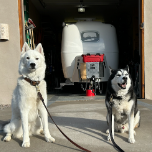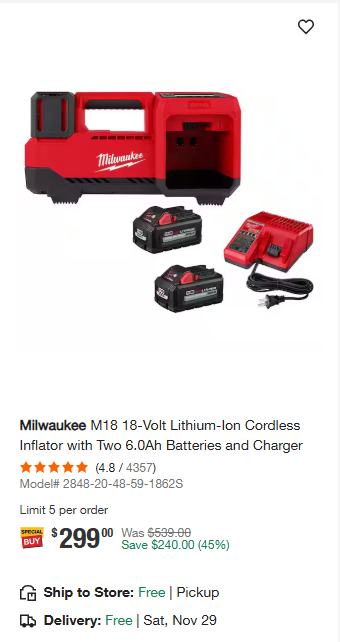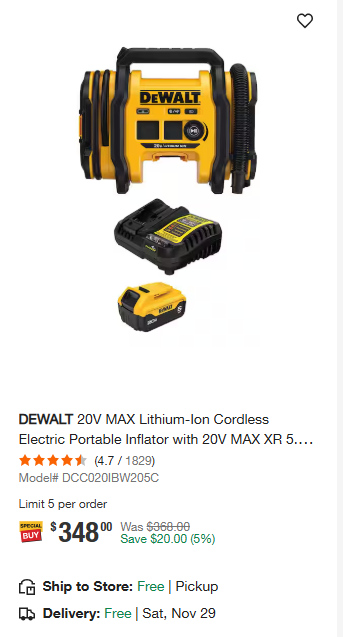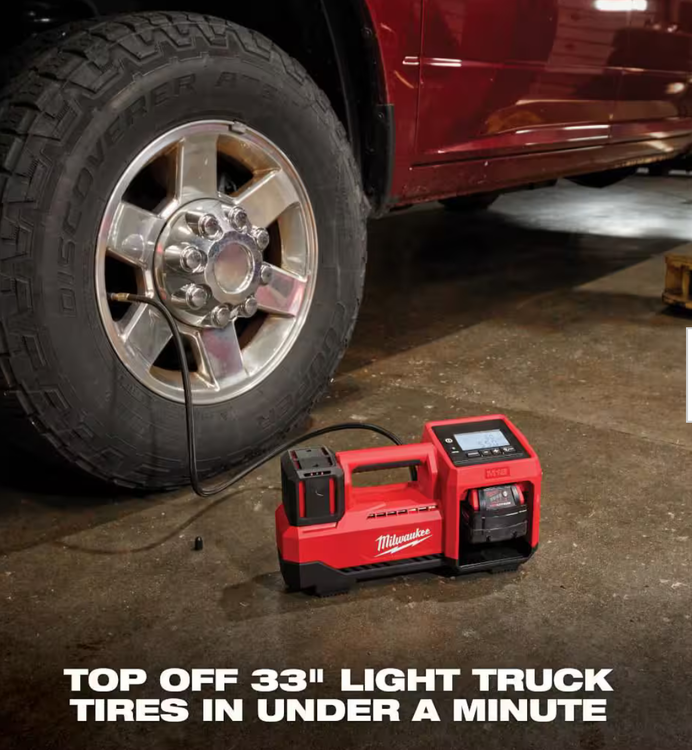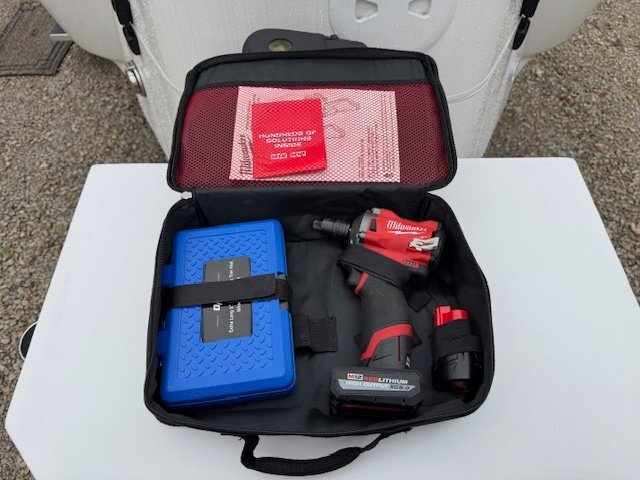-
Posts
439 -
Joined
-
Last visited
-
Days Won
14
Ollie-Haus last won the day on September 24
Ollie-Haus had the most liked content!
My Info
-
Gender or Couple
Couple
-
Location
Indiana
My RV or Travel Trailer
-
Do you own an Oliver Travel Trailer, other travel trailer or none?
I own an Oliver Travel Trailer
-
Hull #
1373
-
Year
2023
-
Make
Oliver
-
Model
Legacy Elite II
-
Floor Plan
Twin Bed Floor Plan
Recent Profile Visitors
2,870 profile views
Ollie-Haus's Achievements
-
Is there a regulatory authority over RV accessories, or would lithium battery suppliers fall under some other regulatory jurisdiction? Not really sure how aftermarket lithium batteries are categorized. Accessories, DIY, OEM, etc. They aren’t specifically dedicated to vehicle or RV markets. Had never really thought about it before.
-
Changing tires in the wild - lessons learned
Ollie-Haus replied to John and Jodi's topic in General Discussion
Totally agree, you stick with the brand and size of battery system you start with. I chose Milwaukee because that's what I used for years at work and was able through work to get significant discounts at the time. Not to start over in retirement, I've continued with the brand. One thing we can do now when replacing an old tool is to buy the new brushless version of tools when available by most companies that offer more powerful and much more efficient motors in the tools that make the batteries last much longer. I have had Dewalt tools a few years ago and loved them and actually still have a drill that still works fine. Regardless of brand, having the right tools on board when out on the road can make for quick and easy repairs and less downtime in an unexpected emergency.👍 PS: If you shop at Home Depot and compare the two brands, you actually get a much better price with the Milwaukee if you are buying the whole kit with batteries. The Milwaukee comes with two larger batteries and charger for a considerably lower price than the similar DeWalt kit which only includes one smaller battery at a higher price. Home Depot is definitely the source for deep discounts on Milwaukee tools. -
Changing tires in the wild - lessons learned
Ollie-Haus replied to John and Jodi's topic in General Discussion
I have a built in compressor on the truck but yes, absolutely need some type of built in or portable air compressor. I personally favor the Milwaukee M18 portable compressor, which happens to be nicely discounted for Black Friday at this time: https://www.homedepot.com/pep/Milwaukee-M18-18-Volt-Lithium-Ion-Cordless-Inflator-with-2-5-0Ah-Batteries-and-Charger-2848-20-48-59-1852B/326514175 -
Changing tires in the wild - lessons learned
Ollie-Haus replied to John and Jodi's topic in General Discussion
My emergency tire service kit includes the following. The reason I carry these items is they take up little space and stow in an easy access location like under the back seat of the truck or in the front tongue box on the Oliver. The Milwaukee charger is mounted on the side wall of our truck bed for anytime access. With that out of the soft case, the impact socket set fits nicely inside the soft case with the light and impact wrench so everything is together. I like having a tire plug kit along because a screw or nail in the tire is the most common cause and as mentioned earlier is the easiest fix and can be done with wheel still mounted to trailer. All these items fit neatly in a small space and are invaluable for getting you safely back on the road in a tire emergency. The most important thing is to try if possible to do an emergency repair away from traffic on a hard level surface. There are other tools you can have along to do a more thorough repair, but this set of tools will get you back on the road and safely to the closest tire shop if needed. This wrench fully charged has enough charge to remove all four wheels on your truck or trailer. The batteries will stay charged for many months in storage. https://www.homedepot.com/p/Milwaukee-M12-FUEL-12V-Li-Ion-Brushless-Cordless-Stubby-1-2-in-Impact-Wrench-Kit-w-2-5-0Ah-1-2-5-Ah-High-Output-Batteries-2563-22-48-11-2450/337134504 The sockets are extra deep so you won't need an extension even with a torque wrench. If needed you can remove the protective sleeve on the socket to fit the lug nut in the wheel. Three sizes to fit most automotive lug nut sizes. https://www.amazon.com/dp/B0C98ZHKQX?ref_=ppx_hzsearch_conn_dt_b_fed_asin_title_7&th=1 12V Milwaukee work light is indispensable in many ways and uses the same battery as the impact wrench. https://www.amazon.com/dp/B0BRZ31ZFS?ref=ppx_yo2ov_dt_b_fed_asin_title Tire plug kits come in many types and sizes. I personally like the mushroom style plugs. https://www.amazon.com/dp/B0FK4SNRBG?ref=ppx_yo2ov_dt_b_fed_asin_title&th=1 -
Yes John those are the external dimensions. I don’t think you would be able to store the unit in the attic space without tilting it on its side. Ours stores very neatly and secure in the upright position under the forward dinette seat space, between the blade valve and the knee space fiberglass wall.
-
So glad to know it performed well for you. I know these are hard to get as the supply is intermittent at best. If anyone else is considering buying one of these, you need to be diligent in watching for availability as they sell out quickly. As @Rolind said, they can be a real game changer, especially in high humidity cool temperature situations. They actually give off a fair amount of heat while running, which allows you to dry out the air in your Oliver and add just enough heat to not require the furnace and remain very comfortable.
-
Not trying to sell anybody, but if you like electric camping alternatives and adding options to your camping utilities, EcoFlow has some real awesome pricing right now on some of their bigger power stations. I'm talking 65% discount from normal pricing. The Delta Pro even has a 30 amp plug right on the panel that can power your camper for a few hours of AC when dry camping overnight. This is what I have in the back of the truck and use it mostly to power our portable fridge, but it offers many options including emergency backup for short power outages at home. I also love that it's a no noise option in the campground. I'll post some links here to the items I spoke of in the previous post for anybody interested. The sky's the limit on this stuff. EcoFlow Delta Pro https://us.ecoflow.com/collections/delta-series/products/delta-pro-portable-power-station?variant=40516140138569 Duxtop portable induction hot plate https://www.amazon.com/dp/B01FLR0ET8?ref=ppx_yo2ov_dt_b_fed_asin_title&th=1 Greenpan ceramic coated induction ready griddle and skillets https://www.amazon.com/dp/B0D2J2LL5B?ref=ppx_yo2ov_dt_b_fed_asin_title&th=1 https://www.amazon.com/dp/B074CWBJ5D?ref=ppx_yo2ov_dt_b_fed_asin_title Storage bag for griddle https://www.amazon.com/dp/B0CZJFFGMM?ref=ppx_yo2ov_dt_b_fed_asin_title
-
I’ve decided to try something new for outdoor cooking. We’ve had the single induction hot plate I mentioned in my post above and it works great both for inside or outside cooking. It’s extremely fast to heat up, and even quicker than gas when adjusting temperature in the middle of cooking. Well we’ve also been hauling a 22 inch folding Blackstone grill around with us for the last 18 months and that’s what we’ve been doing about 90% of our cooking on. Because we’re in the habit of carrying so much gear along with us when we travel, there’s really no room for the Blackstone in the back of the truck, and for that reason I’ve been strapping it on the top of our rear cargo box behind the Oliver. Needless to say I’ve never been very comfortable with that arrangement for a number of reasons, mostly the extra weight it adds to the back of the camper, but also at about 90 pounds, it’s quite heavy and awkward to load up onto the box. After seeing the two burner induction stove Oliver is installing in the new campers, I started thinking about the same concept for a portable induction setup. But I also decided a double burner unit would not be as versatile as just adding a second single burner unit. The double burner models all divide the 1800 watt capacity between the two burners, limiting the cooking heat range of each element. By adding a second single burner hot plate, both would be able to run at the full range of heating capacity at the same time. There are several ways to accommodate the electric demand. I usually set up my camp table next to the curb side outlet for using the hot plate. For the second one I can either run a heavy 25ft cord under the trailer to the pedestal directly, or I can set my EcoFlow lithium power pack under the table and plug directly into it with the second one. I actually did a little experiment this evening running both induction plates off the lithium power pack at the same time just to see how well it would perform and was very pleased with the results. Even with both induction plates running on the highest settings simultaneously, the EcoFlow was still over 1600 watts below its maximum output capacity, and it showed that a full charge would last over an hour at that rate. At a more moderate setting for each hot plate it read that it had about three hours of capacity. I continued my experiment by grilling up two steaks for supper on the system and couldn’t be happier with the results. The steaks were cooked to medium and it took less than fifteen minutes. Including this and the other experimenting I did, the power pack was still at 84% soc, enough for several more meals without recharging. This new cooking arrangement only required the addition of one single element hot plate and an induction ready ceramic coated griddle that spans both hot plates, all of which fits easily in the front closet. And now I won’t have to load and haul the heavy Blackstone around with us anymore. Here are some pictures for entertainment purposes.
-
2026 YM Oliver awning style windows and other changes
Ollie-Haus replied to Patriot's topic in Ollie Modifications
Regarding the induction cooktop, we installed a 36 inch five element cooktop in our house when we remodeled the kitchen a couple years ago. Holy cow that thing is absolutely awesome, even fun to use. Bonus was our wedding gift cookware set from 32 years earlier were already induction compatible. And as others have mentioned, since the ceramic top only sits about an eighth inch above the counter top, it’s just additional counter space. And talk about safe to use, spilled grease will never ignite on the cook surface and you can lay a sheet of paper against the base of a boiling pot of water with no chance of it igniting. And again as mentioned earlier no gas hazard or combustion fumes. Regarding the induction cooktop now offered in the Oliver, just the fact you will no longer need to open a window and turn on the vent fan to run the stove is enough for me to want one. Perhaps necessary if you are deep frying but otherwise no risk or need at all. With that said, I would never remove the remainder of our propane system because I like redundancy, and prefer gas heating hands down. -
2026 YM Oliver awning style windows and other changes
Ollie-Haus replied to Patriot's topic in Ollie Modifications
Having had numerous conversations with Oliver personnel, I can assure you they are looking at every available source of consumer interest in the Oliver brand as well as the general RV customer trends. Nearly every change/upgrade that’s been made in the design package has been spurred by customer and owner suggestions and weighed against cost and benefit for customers and production costs. Streamlining overall brand quality is obviously part of the motivation as well. I’m very confident that cost cutting always comes lower on the list than quality and customer satisfaction. Some changes are unavoidable due to supplier issues, the new windows being the most recent example. One additional reason we can be so pleased with Oliver as a company as they make changes to the design is that they usually try to consider the ability to upgrade previous model years when possible, something other manufacturers couldn’t care less about. I doubt very many current owners will pursue very many of these possible upgrades but if we are in love with one or the other, at least it’s an option. -
Do you drink the water from your fresh tank?
Ollie-Haus replied to Dennis and Melissa's topic in General Discussion
We’ve always drank the water from the fresh tank. A properly sanitized RV fresh tank is no different than any other plastic container that is used to carry and store water. But then again I drank from garden hoses, hand pumps on old farm wells and public water fountains and even artesian springs in many locations without a worry our ill experience most of my life. Unfiltered well water was all I knew until I was an adult. We use a Costco pitcher filter these days for consistent flavor in our morning coffee or tea. -
This seems like a good thread to reinforce a certain logic when it comes to tow vehicles with regard to the LE2. Like a few others here have stated here, I have extensive prior experience towing trailers, to the tune of close to 50 years. This includes rather large livestock trailers and twin engine boat trailers, enclosed and flat bed cargo trailers all the way down to small motorcycle trailers. They all introduce significant challenges depending on the tow vehicle used. Over the years my overall observation in learning from the seasoned veterans along the way is that just enough truck is never enough and there’s no such thing as too much truck, within reason. I’ve pulled trailers that were on the margin of overloading trucks at times and know what that feels like. When people mention white knuckles and pucker factor as it applies to trailering, I’ve experienced firsthand understanding I was at risk on a few occasions. Similar to previous comments once you’ve been there, you always make a point to never let that happen again. When we began formulating our plan to purchase the Oliver, the choice of truck capacity was of little debate. Our previous camper was a 34’ standard with a super slide on one side. I chose a diesel crew cab dually for that rig, and it performed perfectly. For the Oliver I would be towing a couple thousand pounds less and significantly shorter, but I still wanted plenty of truck and decided to downsize to 350 crew cab short bed with a 7.3L gas engine. Still far above the margin of capacity, so a significant safety factor built into the choice. Best part is like others have mentioned, I don’t have the worry about what cargo I want to load into the truck. No white knuckles and no pucker factor. But most of all with the Oliver, we’re way below the need for a WD hitch and that’s important to me. A WD hitch is a way to compensate for when a trailer connects behind the rear axle and weighs in at near or more than the tow vehicle. It’s acceptably effective at restoring controllability to the tow vehicle, but introduces compromises in articulation and can add significant stresses to both vehicles when moving through uneven terrain. I really wanted to avoid the need to manage the rig through situations where I could be risking damage to vehicles or equipment during remote camping/ boon-docking destinations, etc. plus I just didn’t want the added complexity of hitching and unhitching. These kind of threads always generate “lively debate” and I guess that’s fine so that the inexperienced can read the many views people have and hopefully learn the key factors to consider regarding TV choice and safety considerations. If you choose plenty of truck, most of the discussion is just good general knowledge that you won’t have to worry much about. Long winded way of saying that I f someone is asking for my advice, always choose plenty of truck with an abundance of safety margin. Nobody ever complains about having too much truck, but many have learned through any number of experiences that just enough is often never enough. Cheers!😎
-
- 11 replies
-
- 12
-

-

-
Ford Issues "Do Not Drive" Warning and Brake Recall
Ollie-Haus replied to Steve Morris's topic in General Discussion
This was reportedly the result of allowing a trainee to do assembly work while unsupervised!🤨 The problem was actually discovered by a seasoned employee further down the line. They have a record of which trucks he worked on.


